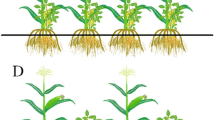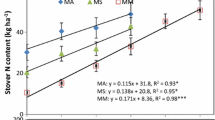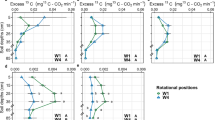Abstract
Background and aim
With a growing focus on soil health, modern agroecosystems have begun to emphasize greater reliance on organic nitrogen (N) sources to meet crop N demands. Teosinte (Zea mays subsp. parviglumis), a wild relative of modern maize (Zea mays subsp. mays), is believed to modulate its belowground carbon (C) allocation based on the type of N in the soil, thus allowing for greater organic N uptake. However, linkages between belowground allocation and N acquisition from organic vs. synthetic N sources remain poorly understood.
Methods
We designed a 13C/15N dual label experiment in which we compared the C allocation patterns of modern maize and teosinte in response to synthetic (urea) and organic (cover crop residue) forms of N.
Results
Teosinte responded to organic N by increasing its biomass root-to-shoot (R:S) ratio by 50% compared to synthetic N, while modern maize maintained the same biomass R:S ratios in both N treatments. Recent photosynthate R:S ratio (measured using 13C-CO2, 7 weeks after establishment) was greater in organic N than in synthetic N treatments for both modern maize and teosinte (91% and 37%; respectively). Label-derived dissolved organic C, representing recent rhizodeposits, was 2.5 times greater in the organic N treatments for both genotypes.
Conclusion
Modern maize took up a similar amount of organic N as teosinte using different C allocation strategies. Our findings suggest that intensive breeding under high N input conditions has not affected this modern maize hybrid’s access to organic N while improving its ability to take up synthetic N.




Similar content being viewed by others
Data availability
The data generated during this project will be made available by the corresponding author upon request.
Abbreviations
- MBC:
-
Microbial biomass carbon
- DOC:
-
Dissolved organic carbon
- MBN:
-
Microbial biomass nitrogen
- TDN:
-
Total dissolved nitrogen
- MAOM:
-
Mineral associated organic matter
- R:S:
-
Root:shoot
References
Abdalla M, Hastings A, Cheng K et al (2019) A critical review of the impacts of cover crops on nitrogen leaching, net greenhouse gas balance and crop productivity. Glob Chang Biol 25:2530–2543. https://doi.org/10.1111/gcb.14644
An T, Schaeffer S, Li S et al (2015) Carbon fluxes from plants to soil and dynamics of microbial immobilization under plastic film mulching and fertilizer application using 13C pulse-labeling. Soil Biol Biochem 80:53–61. https://doi.org/10.1016/j.soilbio.2014.09.024
Bates D, Mächler M, Bolker B, Walker S (2015) Fitting linear mixed-effects models using lme4. J Stat Softw 67:1–48. https://doi.org/10.18637/jss.v067.i01
Blanco-Canqui H, Shaver TM, Lindquist JL et al (2015) Cover Crops and Ecosystem Services: Insights from Studies in Temperate Soils. Agron J 107:2449–2474. https://doi.org/10.2134/agronj15.0086
Bobbink R, Hicks K, Galloway J et al (2010) Global assessment of nitrogen deposition effects on terrestrial plant diversity: a synthesis. Ecol Appl 20:30–59. https://doi.org/10.1890/08-1140.1
Brisson VL, Schmidt JE, Northen TR et al (2019) Impacts of Maize Domestication and Breeding on Rhizosphere Microbial Community Recruitment from a Nutrient Depleted Agricultural Soil. Sci Rep 9:15611. https://doi.org/10.1038/s41598-019-52148-y
Chapman N, Miller AJ, Lindsey K, Whalley WR (2012) Roots, water, and nutrient acquisition: let’s get physical. Trends Plant Sci 17:701–710. https://doi.org/10.1016/j.tplants.2012.08.001
Cheng D, Vrieling K, Klinkhamer PGL (2011) The effect of hybridization on secondary metabolites and herbivore resistance: implications for the evolution of chemical diversity in plants. Phytochem Rev 10:107–117. https://doi.org/10.1007/s11101-010-9194-9
Crews TE, Kemp L, Bowden JH, Murrell EG (2022) How the Nitrogen Economy of a Perennial Cereal-Legume Intercrop Affects Productivity: Can Synchrony Be Achieved? Front Sustain Food Syst 6:755548. https://doi.org/10.3389/fsufs.2022.755548
Dabney SM, Delgado JA, Reeves DW (2001) using winter cover crops to improve soil and water quality. Commun Soil Sci Plant Anal 32:1221–1250. https://doi.org/10.1081/CSS-100104110
Daly AB, Jilling A, Bowles TM et al (2021) A holistic framework integrating plant-microbe-mineral regulation of soil bioavailable nitrogen. Biogeochemistry 154:211–229. https://doi.org/10.1007/s10533-021-00793-9
de Graaff M-A, Van Kessel C, Six J (2009) Rhizodeposition-induced decomposition increases N availability to wild and cultivated wheat genotypes under elevated CO2. Soil Biol Biochem 41:1094–1103. https://doi.org/10.1016/j.soilbio.2009.02.015
Doebley J (1990) Molecular Evidence and the Evolution of Maize. Econ Bot 44:6–27. https://doi.org/10.1007/BF02860472
Doebley J (2004) The Genetics of Maize Evolution. Annu Rev Genet 38:37–59. https://doi.org/10.1146/annurev.genet.38.072902.092425
Dumigan CR, Muileboom J, Gregory J et al (2021) Ancient Relatives of Modern Maize From the Center of Maize Domestication and Diversification Host Endophytic Bacteria That Confer Tolerance to Nitrogen Starvation. Front Plant Sci 12. https://doi.org/10.3389/fpls.2021.660673
Eissenstat DM (1997) Trade-offs in Root Form and Function. In: Jackson LE (ed) Ecology in Agriculture. Academic Press, San Diego, pp 173–199. https://doi.org/10.1016/B978-012378260-1/50007-5
Galloway JN, Townsend AR, Erisman JW et al (2008) Transformation of the Nitrogen Cycle: Recent Trends, Questions, and Potential Solutions. Science 320:889–892. https://doi.org/10.1126/science.1136674
Gaudin ACM, McClymont SA, Raizada MN (2011) The nitrogen adaptation strategy of the wild teosinte ancestor of modern maize, Zea mays subsp. parviglumis. Crop Sci 51:16
Grandy AS, Daly AB, Bowles TM et al (2022) The nitrogen gap in soil health concepts and fertility measurements. Soil Biol Biochem 175:108856. https://doi.org/10.1016/j.soilbio.2022.108856
Hafner S, Unteregelsbacher S, Seeber E et al (2012) Effect of grazing on carbon stocks and assimilate partitioning in a Tibetan montane pasture revealed by 13CO2 pulse labeling. Glob Change Biol 18:528–538. https://doi.org/10.1111/j.1365-2486.2011.02557.x
Jilling A, Keiluweit M, Contosta AR et al (2018) Minerals in the rhizosphere: overlooked mediators of soil nitrogen availability to plants and microbes. Biogeochemistry 139:103–122. https://doi.org/10.1007/s10533-018-0459-5
Johnson IR (1990) Plant respiration in relation to growth, maintenance, ion uptake and nitrogen assimilation. Plant Cell Environ 13:319–328. https://doi.org/10.1111/j.1365-3040.1990.tb02135.x
Keeling CD (1960) The concentration and isotopic abundances of carbon dioxide in the atmosphere. Tellus 12:200–203. https://doi.org/10.3402/tellusa.v12i2.9366
Kelly C, Haddix ML, Byrne PF et al (2022) Long-term compost amendment modulates wheat genotype differences in belowground carbon allocation, microbial rhizosphere recruitment and nitrogen acquisition. Soil Biol Biochem 172:108768. https://doi.org/10.1016/j.soilbio.2022.108768
Kuznetsova A, Brockhoff PB, Christensen RHB (2017) lmertest package: tests in linear mixed effects models. J Stat Softw 82:1–26. https://doi.org/10.18637/jss.v082.i13
Kuzyakov Y (2006) Sources of CO2 efflux from soil and review of partitioning methods. Soil Biol Biochem 38:425–448. https://doi.org/10.1016/j.soilbio.2005.08.020
Lenth R, Buerkner P, Herve M et al (2020) Emmeans: estimated marginal means, aka least-squares means. https://cran.r-project.org/web/packages/emmeans/index.html
Lynch LM, Machmuller MB, Cotrufo MF et al (2018) Tracking the fate of fresh carbon in the Arctic tundra: Will shrub expansion alter responses of soil organic matter to warming? Soil Biol Biochem 120:134–144. https://doi.org/10.1016/j.soilbio.2018.02.002
Meier IC, Finzi AC, Phillips RP (2017) Root exudates increase N availability by stimulating microbial turnover of fast-cycling N pools. Soil Biol Biochem 106:119–128. https://doi.org/10.1016/j.soilbio.2016.12.004
Näsholm T, Kielland K, Ganeteg U (2009) Uptake of organic nitrogen by plants. New Phytol 182:31–48. https://doi.org/10.1111/j.1469-8137.2008.02751.x
Pausch J, Tian J, Riederer M, Kuzyakov Y (2013) Estimation of rhizodeposition at field scale: upscaling of a 14C labeling study. Plant Soil 364:273–285. https://doi.org/10.1007/s11104-012-1363-8
Post DM (2002) Using Stable Isotopes to Estimate Trophic Position: Models, Methods, and Assumptions. Ecology 83:703–718. https://doi.org/10.1890/0012-9658(2002)083[0703:USITET]2.0.CO;2
R Core Team (2020) R: A language and environment for statistical computing. R foundation for statistical computing. Vienna, Austria. https://www.R-project.org/
Ranum P, Peña-Rosas JP, Garcia-Casal MN (2014) Global maize production, utilization, and consumption. Ann NY Acad Sci 1312:105–112. https://doi.org/10.1111/nyas.12396
Reich PB, Tjoelker MG, Pregitzer KS et al (2008) Scaling of respiration to nitrogen in leaves, stems and roots of higher land plants. Ecol Lett 11:793–801. https://doi.org/10.1111/j.1461-0248.2008.01185.x
Rinkes ZL, Weintraub MN, DeForest JL, Moorhead DL (2011) Microbial substrate preference and community dynamics during decomposition of Acer saccharum. Fungal Ecol 4:396–407. https://doi.org/10.1016/j.funeco.2011.01.004
Schmidt JE, Poret-Peterson A, Lowry CJ, Gaudin ACM (2020a) Has agricultural intensification impacted maize root traits and rhizosphere interactions related to organic N acquisition? AoB PLANTS 12:plaa026. https://doi.org/10.1093/aobpla/plaa026
Schmidt JE, Mazza Rodrigues JL, Brisson VL, Kent A, Gaudin ACM (2020b) Impacts of directed evolution and soil management legacy on the maize rhizobiome. Soil Biol Biochem 145:107794. https://doi.org/10.1016/j.soilbio.2020.107794
Taylor HH (1994) Fertilizer Use and Price Statistics, 1960–93. USDA ERS, Statistical Bulletin No. 893. https://doi.org/10.22004/ag.econ.154834
USDA National Agricultural Statistics Service (2017) NASS-Quick Stats [dataset]. Retrieved from https://agdatacommons.nal.usda.gov/articles/dataset/NASS_-_Quick_Stats/24660792
Wang R, Bicharanloo B, Shirvan MB et al (2021) A novel 13C pulse-labelling method to quantify the contribution of rhizodeposits to soil respiration in a grassland exposed to drought and nitrogen addition. New Phytol 230:857–866. https://doi.org/10.1111/nph.17118
Weintraub MN, Scott-Denton LE, Schmidt SK, Monson RK (2007) The effects of tree rhizodeposition on soil exoenzyme activity, dissolved organic carbon, and nutrient availability in a subalpine forest ecosystem. Oecologia 154:327–338. https://doi.org/10.1007/s00442-007-0804-1
Wickham H (2016) ggplot2: Elegant Graphics for Data Analysis. Springer-Verlag, New York
Yan M, Pan G, Lavallee JM, Conant RT (2020) Rethinking sources of nitrogen to cereal crops. Glob Chang Biol 26:191–199. https://doi.org/10.1111/gcb.14908
York LM, Galindo-Castaneda T, Schussler JR, Lynch JP (2015) Evolution of US maize (Zea mays L.) root architectural and anatomical phenes over the past 100 years corresponds to increased tolerance of nitrogen stress. J Exp Bot 66:2347–2358. https://doi.org/10.1093/jxb/erv07
Acknowledgements
The authors would like to thank Physics Machine Shop staff for their help with labeling chamber construction; Dr. Ann Hess of Department of Statistics for data analysis assistance; Tad Trimarco, Tayin Wang, and Bo Collins for lab and greenhouse help; EcoCore staff for sample analysis; staff at the Colorado State University Plant Growth Facility for technical support; and staff at the USDA Akron research station for support with collecting soil. We would also like to thank members of the Agroecology lab group and Cotrufo lab group for their valuable inputs before and after the experiment. This project was supported by USDA NIFA postdoctoral fellowship (Award # 2017-67012-26112) awarded to MB Machmuller. We also acknowledge funding from the Foundation for Food and Agricultural Research (FFAR) and the Land Institute to support Siwook Hwang as a FFAR fellow while conducting this research.
Funding
This project was supported by USDA NIFA postdoctoral fellowship (Award # 2017–67012-26112) awarded to MB Machmuller. We also acknowledge funding from the Foundation for Food and Agricultural Research (FFAR) and the Land Institute to support Siwook Hwang as a FFAR fellow while conducting this research.
Author information
Authors and Affiliations
Corresponding author
Ethics declarations
Competing interests
The authors have no relevant financial or non-financial interests to disclose.
Additional information
Responsible Editor: Devrim Coskun.
Publisher's Note
Springer Nature remains neutral with regard to jurisdictional claims in published maps and institutional affiliations.
Supplementary Information
Below is the link to the electronic supplementary material.
Rights and permissions
Springer Nature or its licensor (e.g. a society or other partner) holds exclusive rights to this article under a publishing agreement with the author(s) or other rightsholder(s); author self-archiving of the accepted manuscript version of this article is solely governed by the terms of such publishing agreement and applicable law.
About this article
Cite this article
Hwang, S., Machmuller, M.B., Gaudin, A.C.M. et al. A teosinte and modern maize hybrid use different carbon allocation strategies in response to cover crop residue nitrogen. Plant Soil (2024). https://doi.org/10.1007/s11104-024-06494-0
Received:
Accepted:
Published:
DOI: https://doi.org/10.1007/s11104-024-06494-0




